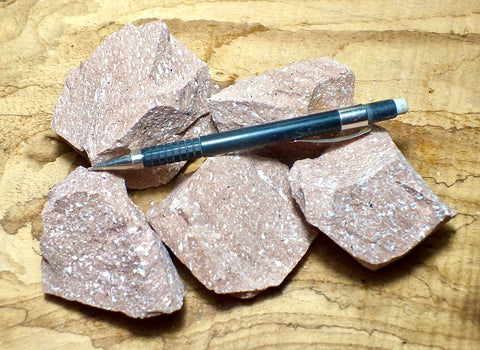rhyolite porphyry - pinkish tan porphyritic rhyolite - Unit of 5 student specimens
$ 4.20
Porphyries are igneous rocks that exhibit two stages of cooling. First, slow cooling deep underground gives crystals of feldspar time to grow large, and second, more rapid cooling near the surface freezes the other minerals before they form crystals large enough to be visible to the naked eye.
Feldspar is the first mineral to crystallize. Crystals of feldspar float around in the magma and are carried upward toward the surface as a magma body rises. As the magma temperature drops, quartz, mica and other minerals form a fine-grained mass of much smaller crystals around the phenocrysts of feldspar.
In this porphyry, the feldspar phenocrysts have been converted to kaolin, so they are pseudomorphs of kaolin after orthoclase. They retain the shape but, unlike orthoclase, can be scratched by a knife. The composition of the phenocrysts was recently identified by x-ray reflection spectroscopy. Since feldspar alters to clay, this shouldn't have been a surprise.
An earth science student should recognize this as a rhyolite, the extrusive equivalent of a granite, with a similar silica-rich composition. I would give additional credit to a student who identified this as a porphyry, since the phenocrysts are small. The surrounding mass of microscopic crystals is typical of rhyolites - the texture of rhyolite is normally aphanitic, from the Greek words, a = not and phaneros = visible, referring to the crystals.
The small size of the phenocrysts in this rhyolite porphyry should also tell students that this started to cool at depth, allowing feldspar crystals to form, but the magma didn't stay there long before it was brought to the surface where it cooled rapidly. Greater time at depth would have resulted in larger phenocrysts.
Phenocrysts, crystals that are larger than the crystals surrounding them, are named from the Greek phaino for appear. If you are a science or earth science teacher purchasing this as a teaching specimen for your class, consider having your students compare this with a rhyolite porphyry that cooled longer at depth. We often have examples with large feldspar crystals that had time to grow large because the magma remained far below the surface and stayed hot before finally being pushed upward to the surface.
Rhyolite is the volcanic surface-cooled equivalent of plutonic granitic rocks that cool at depth, and it is rich in silica. This makes rhyolite flows viscous - they do not flow over wide areas as does silica-poor basalt. Rhyolite varies widely in appearance, and is often stained by impurities. Because of the rapid cooling, the crystalline nature of rhyolite is often hard to detect. Tuff, welded volcanic ash with the same composition, can look similar, though tuffs often have angular clasts, broken fragments (from the Greek klastos for broken in pieces) of other igneous rocks that were torn from the walls of the vent and welded into the tuff.
With a careful look and the aid of a hand lens, you can find an occasional phenocryst that has broken parallel to the cleavage in these specimens, showing the rectangular shape typical of feldspar crystals. I would ask the students to identify this as a rhyolite, and to be able to tell me that it didn't spend much time at depth before it was carried up to the surface. More advanced students should see this as a porphyry, not just rhyolite.
Shipping: By Priority Mail or USPS Ground Advantage, whichever is cheaper, unless we find a better rate. Click > here < for shipping rates. Use back button to return to this page.
Making multiple purchases? Click on the "combine shipping" button in the shopping cart. We'll send an invoice with combined shipping. A link in that invoice will bring you back to checkout, no hassle.


